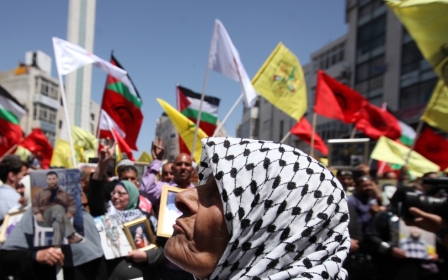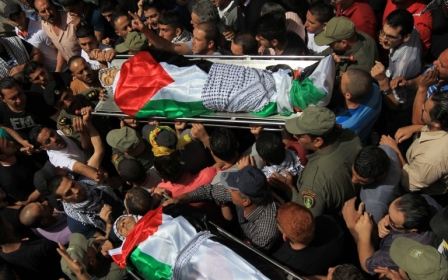West Bank new mecca for ‘conflict tourists’

It’s Friday in the village of Bil’in, the occupied West Bank. Young men with kuffiyah (scarf)-covered faces launch rocks through the air, while fully armed soldiers on the other side of the separation wall fire white ribbons of gas canisters back. It’s hard to breathe and almost impossible to see through the thick haze and sharp burn of the stinging tear gas. In the middle of it all, a disoriented foreigner is handed a kuffiiyah by a local to cover his face, and directed out of the gas clouds into fresh air.
Bil’in’s Friday demonstration, like many others in villages up and down the occupied West Bank, is in protest against the Israeli separation wall that restricts movement and cuts off dozens of villages from their land and natural water sources. While these protests are popular fronts and Palestinian led, international activists also play a role in documenting clashes and blocking locals from being arrested by the army.
At every village protest there are distinct groups who have clear roles. Village protesters chant political slogans and wave flags; the shabaab (young men) resist occupation through throwing stones; journalists document the events, and activists often step in to defuse tensions between the army and locals.
However, over the past few years, foreigners have started to show up not as activists or reporters, but as tourists merely out of curiosity.
“I’ve heard from many people saying that they think Bil’in is like Egypt now with all the tourists coming,” Haitham Al Khatib, a resident of Bil’in said.
New MEE newsletter: Jerusalem Dispatch
Sign up to get the latest insights and analysis on Israel-Palestine, alongside Turkey Unpacked and other MEE newsletters
Dr Rami Isaac, a senior lecturer in tourism at the Netherlands’ Breda University, who specialises in tourism in conflict zones, told Middle East Eye that the phenomenon is on the rise in the occupied West Bank and in conflict areas around the world.
“In many places, tourists are attracted not despite of conflict, but because of this conflict,” Isaac said.
According to activist groups across the West Bank, conflict tourism is a small but rising trend. Within the past five years it has developed into a noticeable aspect of protests in villages, particularly in Bil’in, where clashes tend to be less intense than other villages.
‘Come on and see the action!’
Three years ago Bil’in succeeded in getting the separation wall moved and reclaimed some of its land, becoming a role model for other villages. Its popular resistance has been well documented around the world, for instance in the Oscar-nominated documentary Five Broken Cameras.
Because of this coverage, Bil’in has become a prime destination for conflict tourists. Tour groups are common in the village, with young children often selling them bracelets and bags emblazoned with Palestinian flags.
“Come on and see the action!” a tour guide yells out of the window of his van as cars line up to drive down to the village’s protest site. The van, registered with a tour company in Tel Aviv, is packed with tourists who have paid to witness the village’s struggle first hand.
Minutes into the protest, the Israeli army begins to fire tear gas from behind the separation wall onto the crowd. In the midst of it, a tourist from a local tour group is hit on the leg by a bouncing canister. The man’s fluffy pink towel around his neck makes him stand out, in contrast to the gas masks and kuffiyehs of the locals, activists and journalists. He and his friend described the scene as “scary, but fun” as they leave the main protest and retreat back.
The visitors said it was their first time at a protest and their first day in the occupied West Bank. They said they had come to Bil’in as part of a tour organized by Hostel in Ramallah, a backpacker’s hostel that they had checked into that morning. Along with other tourists at the protest, the two (an American and South African) posed for photos while the protest continued in the distance.
On the same day, another visitor with a different tour group attempted to throw a rock in the general direction of the army as a friend captured the moment on her smartphone.
According to the Palestinian Popular Committee in the West Bank village of Nabi Saleh, the ramifications of rock throwing at protests can often involve night raids on villages where tear gas is fired into homes and young men are arrested. This risk is one that young men across the West Bank only take with an understanding of the consequences.
While rock throwing done by conflict tourists may be a small minority, activists and protest regulars in villages like Bil’in, Nil’in and Nabi Saleh say that posing for pictures is a common occurrence that undermines the demonstrations.
Educational experience
Al Khatib believes that most of the people from Bil’in think tourists could be good for the village because even if they come as tourists, some leave as activists.
“Some of them can be good for Bil’in, because if they go home and they know the story maybe after they will become activists,” Al Khatib said. “But for many of them I don’t know what they are going to do after Palestine, many of them we never hear of them again, they were just travelling.”
Hostel in Ramallah representative Hens Ladekarl stressed to MEE that many of the tourists that take the tour to Bil’in do so as an alternative educational experience and that is how the tour is planned.
“Even though they may know nothing about what’s going on, they still leave here with at least an interest about what is happening,” Ladekarl said. “What I’ve experienced in the hostel is that every one of [the tourists] come out with a million questions.”
When asked about whether hostel residents were supplied with any safety equipment, appropriate clothing, or any protection against tear gas inhalation, Ladekarl said such items were not supplied, but the hostel advised tourists to stay towards the back of the protest and were given a rundown on what to expect during the clashes.
“I think it’s very, very important to distinguish between the really small minority that come here and act like idiots and the normal tourists who actually come here to experience what’s going on,” Ladekarl told MEE. He stressed that Hostel in Ramallah’s protest tours are meant to be educational, similar to the alternative political tours which teach tourists about the history of the conflict and current political conditions.
However, Dr Isaac believes alternative political tours instead of protest tours are a much better first step for tourists to take when they come to Palestine because they teach the history of the conflict and current political conditions.
“These tours can be the first step towards transformation of tourists, changing their attitudes about the conflict. When they return home they will potentially put pressure on their own governments and community groups to raise their voice against Israeli occupation. After some time, these tourists may return to Palestine for a longer period of time, and with their knowledge and insight, are in a much better position to start marching with Palestinians in protests,” Isaac said.
Middle East Eye delivers independent and unrivalled coverage and analysis of the Middle East, North Africa and beyond. To learn more about republishing this content and the associated fees, please fill out this form. More about MEE can be found here.




